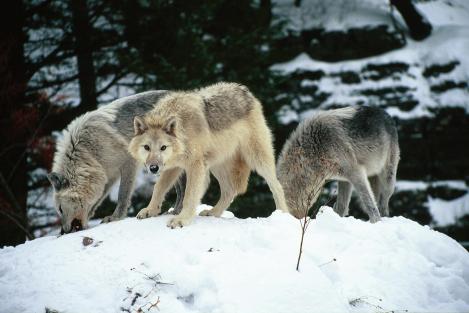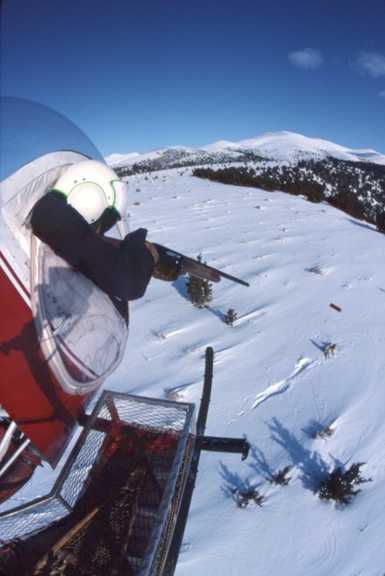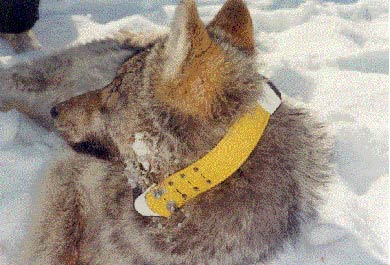Lost Creek Pack – Courtesy John Burch
It’s deja vu for wolves in Alaska’s Yukon–Charley Rivers National Preserve. All eleven members of the Lost Creek Pack were wiped out by state biologists when they left the protection of the Yukon-Charley Rivers National Wildlife Preserve, just as the Webber Creek Pack was gunned down in 2010 in almost exactly the same scenario. Both packs had been the focus of long time studies. The Lost Creek Pack for twenty years, the Webber Creek Pack for 16 years.
Alaska is a killing ground for wolves. The state treats wolves and bears like vermin, killing them with impunity to boost ungulate populations. They are disgusting.
====
Alaska’s Republican governors find vicious ways to kill predators and mark their territory with the feds.

Courtesy of John Burch
John Burch spent 20 years studying a family of 11 wolves. Then one day last winter, the entire pack was shot dead.
The wolves were called the Lost Creek pack, and they’d carved out a territory along the border of Yukon–Charley Rivers National Preserve, deep in the Alaskan interior. Burch, a National Park Service biologist, had been using radio collars to follow the wolves as they hunted caribou, mated, and raised pups, mostly within the boundaries of the 2.5 million–acre preserve of boreal forest, open tundra, and massive river valleys east of Fairbanks. As long as the wolves stayed inside Yukon–Charley, they were relatively safe. Cross the preserve’s invisible border, though, and they were running for their lives.
That’s because Yukon–Charley abuts one of Alaska’s “predator control” units, where state agencies kill wolves and bears to boost populations of moose, caribou, and other animals that people eat. In February, after the Lost Creek pack loped past the border of Yukon–Charley, state biologists shot all 11 wolves from a helicopter, wiping out 20 years of research in a single day. Had it been a few years earlier, the state agents charged with predator control would’ve seen Burch’s radio collars and spared at least some of the Lost Creek pack. But no longer, Burch says: “There’s no negotiations anymore. They kill almost all the wolves they can find. These last two winters they’ve pretty well gotten most of them.”
As harsh as it can seem, many Alaskans defend predator control, arguing that environmentalists from the Lower 48 who’ve squandered their own wilderness for interstates and strip malls don’t understand how important it is for Alaskan families to be able to shoot a caribou or moose. In many ways, they’re right: With a box of cereal costing as much as $14 and a gallon of milk $10, getting through a winter in rural Alaska often depends on successful hunting, which in turn depends on healthy caribou herds.
State law requires wildlife managers to maintain high populations of game animals like caribou. When the law went into effect in 1994, Democrat Tony Knowles was governor, and he carried it out through nonlethal (but expensive) methods like sterilizing female wolves and relocating packs from places where food security was most important to people. But under the state’s past three Republican governors, predator control has been ramped up, and relations between state and federal wildlife agencies have broken down.
It started in 2002, when Republican Frank Murkowski took office. One of Murkowski’s first actions was to revamp the Alaska Board of Game, the body responsible for most wildlife decisions. Before long, the new board allowed state agents and hunters to gun down wolves and bears from the air. And in places like Yukon–Charley, where the National Park Service prohibits predator control, the board instead tried to increase bag limits and extend wolf and coyote season to months when the animals have pups in tow.
During the tenures of the next two Republican governors—Sarah Palin and Sean Parnell—predator control grew even more intense. The board eliminated a122-square-mile buffer protecting wolves around Denali National Park, allowed hunters to bait bears with doughnuts and bacon grease, and approved “spotlighting,” or using a bright light to rouse black bears from their dens to shoot them as they emerge. “There’s been a focused effort to dramatically reduce populations of wolves, coyotes, and bears,” says Knowles. “And the methods and means they’ve used are both unscientific and unethical.”
Though the state’s tactics have little chance of actually endangering Alaska’s bear or wolf populations as a whole, they’re essentially a big middle finger to the feds. Hunting is allowed in Alaska’s national preserves, but blatantly manipulating the balance of predators and prey violates the 1916 Organic Act that created the national park system. So since 2001, the National Park Service has asked the state Board of Game 60 times to exempt hunting practices that unfairly manipulate the predator-prey balance from Alaska’s national preserves. Each time, the board has refused. So again and again, the National Park Service is forced to overrule them.
That doesn’t sit well with Alaskan wildlife officials. Being told how to do their job by the National Park Service offends them about as much as does the Environmental Protection Agency trying to put the kibosh on Pebble Mine, the proposed open-pit copper mine that Gov. Parnell would love to see built in the headwaters of one of the world’s most prolific salmon fisheries. “Federal overreach is nothing new,” says Ted Spraker, chairman of the Alaska Board of Game. “But in the last decade it’s really kicked into high gear.” Killing the Lost Creek wolves was part of a clear message from the Parnell administration: The EPA and the National Park Service aren’t in charge here.
In other words, hunting will still be allowed in national preserves, but no matter who’s in office, the land won’t be managed like a giant game farm. The rule is up for public comment now and will probably be implemented next year.
And in 2010 almost the same scenario
Alaska Fish and Game Wipes Out Collared Wolf Pack From National Preserve
March 19, 2010
Alaska won’t stop killing wolves.
Alaska Fish and Game wiped out all four members of the collared Webber Creek wolf pack that ranged in Alaska’s Yukon-Charley Rivers National Preserve. They were part of a sixteen year ongoing research project by the National Park Service.
Alaska is killing wolves to boost numbers of moose and Fortymile caribou. This is a waste of wolves’ lives and outdated wildlife management. Are they living in the 1950’s up there?
The Alaska Fish and Game wolf executioners agreed they wouldn’t kill wolves collared by the National Park Service biologists. So much for giving their word.
Wolves that use the preserve are dropping like flies. The autumn 2009 count was 42 wolves, by February that number had dropped to 26, the largest single decline in 17 years. There should be an immediate halt to the wolf killing anywhere near the preserve.
“Fish and Game makes no apologies for killing uncollared wolves in the predator control program and said it killed the wolves wearing park service radio collars by mistake. “A possible collar malfunction or other problems prevented staff from identifying the collared wolves,” the department said in a statement Thursday.”
Collar malfunction? I was born in the dark but it wasn’t last night.
The Webber Creek mother and father were recently collared. Apparently the shooter did see the collars but shot anyway, according to reports.
“Causes of the tracking problem are being investigated, according to the statement.
Fish and Game referred all questions to David James, regional supervisor for the Interior. James did not return repeated messages Thursday afternoon and evening with questions about what happened and the department’s statement, which appears to conflict with what he had reportedly told the Park Service.Dudgeon said he’d spoken to James on Wednesday night.”My understanding from the phone call last night was that the shooter, whoever that person was, did see the collars,” Dudgeon said. “They were aware of the collars.”The Fish and Game statement began by saying the department was “concluding a successful three-day field operation in the ongoing Upper Yukon Tanana wolf control program.” The operation began Tuesday and the statement said that nine wolves were killed during the first two days.The program will resume with the next adequate snowfall in the area, according to the statement. The wolves are tracked in the snow using fixed-wing aircraft, and Fish and Game employees then come in and shoot the wolves from helicopters.There are five areas of Alaska where the state has authorized predator control from the air by private pilots and gunners in order to boost key populations of game. The Fortymile area is the only of the five where Fish and Game also uses helicopters with its own employees to fly in and shoot the wolves.Fish and Game said it “continues to coordinate” with National Park Service staff to minimize the impact of the effort on the wolf study in the Yukon Charley preserve. The study has been ongoing for 16 years, and the “alpha male and female” killed had been recently fitted with collars.Dudgeon said he would be asking the department exactly where the wolves were killed and why. He said he’d asked Fish and Game not to kill any collared wolves, as well as any other wolves in the same packs.Dudgeon said he made the request because of population numbers for wolves using the preserve. He said 42 wolves were counted in the fall and 26 in February. Wolves always die over the winter, but it was the biggest drop since the preserve started monitoring in 1993, he said.He said Fish and Game agreed not to kill collared wolves and take no more than seven from the biggest packs that move in and out of the Yukon Charley preserve.The National Parks Conservation Association, an advocacy group, called Thursday for an immediate suspension of the wolf killing around the Yukon Charley preserve. The group said it shouldn’t resume until the Park Service is satisfied a healthy wolf population is assured.
Wolf advocate Rick Steiner called the killing of collared wolves “disgusting and shameful” and said the program should be halted. The Board of Game authorized predator control after hearing from local residents and hunting advocates.This is the second year in a row the department has used helicopters to kill wolves in the area of the Fortymile caribou herd. Fish and Game reported killing 84 wolves in the aerial program last year.”
Alaska has a reputation for treating its predators like vermin. It’s clear when it comes to predators, Alaska caters to hunters and trappers, the rest of the wildlife viewing public be damned.
The Webber Creek wolves resided in the Yukon-Charley Rivers National Preserve. Alaska Fish and Game agreed they would leave the collared wolves alone, yet the wolves are dead.
Please contact Governor Parnell to express your outrage.
“Friends of Animals“ has called for a boycott of Alaska due to the terrible decision by Alaska’s Board of Game to extend trapping into buffer zones around Denali National Park.
This is just another reason to avoid Alaska. Is there no end to their sanctioned wolf slaughter?
Contact Governor Parnell…..CLICK HERE
Alaska Governor Sean Parnell
State Capitol
P.O. Box 110001
Juneau, AK 99811
Fax:(907)465-3532
Tel:(907)465-3500
email: governor@gov.state.ak.us
web: http://www.gov.state.ak.us
===========
ALASKA DEPARTMENT OF FISH AND GAME
Boards Support Section
P.O. Box 115526
Juneau, AK 99811-5526
(907) 465-4110
(907) 465-6094 FAX
====
Collared wolves killed during predator control
By SEAN COCKERHAMPublished: 03/19/1012:38 am | Updated: 03/19/1012:38 am
============
Wolves with radio collars for research killed during Alaska predator control culling
The Anchorage Daily News
By Sean Cockerham |
Posted in: Alaska’s wolves, aerial gunning of wolves, gray wolf
Tags: collared wolves, aerial gunning of wolves, Yukon-Charley National Preserve, wolves in the crossfire, Alaska Department of Fish and Game, Webber Creek Pack, Lost Creek Pack, open season on wolves, John Burch


























 Boulder White Clouds Council
Boulder White Clouds Council Exposing The Big Game
Exposing The Big Game Footloose Montana
Footloose Montana Friends of the Clearwater
Friends of the Clearwater Lockwood Animal Rescue Center
Lockwood Animal Rescue Center Louise du Toit
Louise du Toit LUPUSLAETUS
LUPUSLAETUS Mercy For Animals
Mercy For Animals Northern Idaho Wolf Alliance (NIWA)
Northern Idaho Wolf Alliance (NIWA) Predator Friendly®- Because Wildlife Matters
Predator Friendly®- Because Wildlife Matters Project Coyote
Project Coyote Project: Wolf
Project: Wolf The Nature Conservancy
The Nature Conservancy The Ravensong Group
The Ravensong Group WildEarth Guardians
WildEarth Guardians Wisconsin Wildlife Ethic-Vote Our Wildlife
Wisconsin Wildlife Ethic-Vote Our Wildlife Wolf And Wildlife Studies: Jay Mallonee (Independent Wolf Biologist)
Wolf And Wildlife Studies: Jay Mallonee (Independent Wolf Biologist) Wolf Song of Alaska
Wolf Song of Alaska Wolves in english ! Les loups en anglais !
Wolves in english ! Les loups en anglais ! WWP's Gray Wolf Page
WWP's Gray Wolf Page Yellowstone To Yukon Conservation Initiative
Yellowstone To Yukon Conservation Initiative